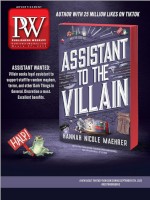I’m thrilled that Pam Anderson’s new book made it to the New York Times bestseller list. The memoir, Love, Pamela, represents the author’s attempt to take back the tale that has been crafted about her. It is, according to jacket copy, the account of a “free spirit” who stands firm as “a strong, creative, confident woman.”
I have a personal interest in what Pam has to say. I was her editor on her first bestseller, Star, a fictionalized narrative that tells what happens “when the A-list meets the D-cup.” That line is also from jacket copy. I remember it well because I wrote it.
In 2004 I was working at Atria Books, a newly formed division of Simon & Schuster. I myself was newly formed, having just been promoted to senior editor. I had worked toward the title for years, after starting at S&S as a summer intern. Now that the role was mine, I wasn’t sure I was ready for it. I certainly didn’t know why Atria’s founding publisher, Judith Curr, had offered the obvious bestseller to me. Maybe it was that, like Pam, I was Canadian. More likely it was because I was eager to please, because I said yes to everything.
The first time I spoke with Pam, I told her how thrilled I was to be working with her. That wasn’t exactly true. I believed in the book’s potential and was glad to have it on my list, but when I went into publishing, it wasn’t to work with Hollywood celebrities. Like so many young women, I had entered the field with the lofty notion that I would edit literary fiction, possibly even discover the next Alice Munro or Toni Morrison. It never occurred to me that I would help put the Baywatch babe on the bestseller list.
I’ve since learned that distinctions such as “literary” and “commercial” don’t mean as much to the reader as they do to editors and agents (never mind that the line between these two categories can easily be blurred). The most important point is, what’s the story? Does it have what it takes to keep the reader turning the page? Will readers care about the protagonist—in this case, an actor who had crafted her own persona, much like Marilyn Monroe and Dolly Parton before her?
Pam was a natural storyteller who instinctually knew what people wanted from her. She nodded appreciatively when I told her that the book would be fun, a love letter to her fans—and sexy, of course. It had to be sexy. “I want this to be a book that people masturbate to,” a giddy Pam told me.
All right then, I thought, wondering whether this would make it character- or plot-driven.
Category aside, a book needs to be faithful to the writer’s intention. It was this last point—my author’s intention—that was making me nervous. Pam had been burned once, walking away from Pamdemonium, an account of her life that was to be part narrative, part scrapbook. It was a genius title and concept, but the publisher had made a big mistake with the ghostwriter—a straight man who wrote sentences like “I ran across the beach, my breasts bouncing.”
Pam had canceled that project. I didn’t want to lose a potential top seller, nor did I want my author to be uncomfortable. The novel—which was Judith’s brilliant idea—offered Pam a way to share what she wanted while keeping other details under wraps. The concept of roman à clef thrilled her.
“So, I keep the key to the story,” Pam said. “I like that.”
Satisfied that she didn’t have to divulge anything she wasn’t prepared to, she approved ghostwriter Eric Shaw Quinn to help her bring her story to life. When he called to tell me of the gift she had sent—a pair of Lucite platform heels with a note that read, “Eric, if you’re going to help me tell my story, you’re going to have to walk a mile in my shoes”—I knew everything was going to work out okay.
Pam may have played the dumb blonde to her benefit, but she was pretty canny. It wasn’t just the way the self-described feminist presented her protagonist as someone people “tended to underestimate.” It was the way she pushed back when I wanted her to include more explicit sex scenes. That shouldn’t have surprised me; Pam had no problem saying no.
“Find out who you are and do it on purpose,” Dolly Parton said. At a time when I was still figuring out who I wanted to be, it was pretty wonderful to be around a woman who knew exactly who she was. So what if I didn’t discuss the Oxford comma with my author? I helped her tell a really good story that delighted readers. I also helped remove hot rollers from her hair in her suite at the St. Regis, a story I now get to share myself.



 Volume 270
Issue 13
03/27/2023
Volume 270
Issue 13
03/27/2023





